A 4-day Late Spring Private Tour arranged for Croydon RSPB Group. We enjoyed some nice weather, with lots of sunshine, but with a cool N/NE/E wind coming in off the North Sea. Camera failure means there are fewer images than normal for the blog this time…
Wednesday 24th May
The 24th was a half day, after the group had traveled up to Norfolk in the morning. We met up at Le Strange Arms in Hunstanton at 1pm. A Red-backed Shrike had been found in Burnham Overy Dunes in the morning, so we had a choice between going out to look for that, or opting for a more gentle introduction – the group voted for the former.
We parked in the car park at the Staithe and walked up the seawall. There were several Little Terns in the harbour, loafing on the sand on the far side of the channel or chasing round over the boats calling. A couple of Common Terns were dozing on the sand too.
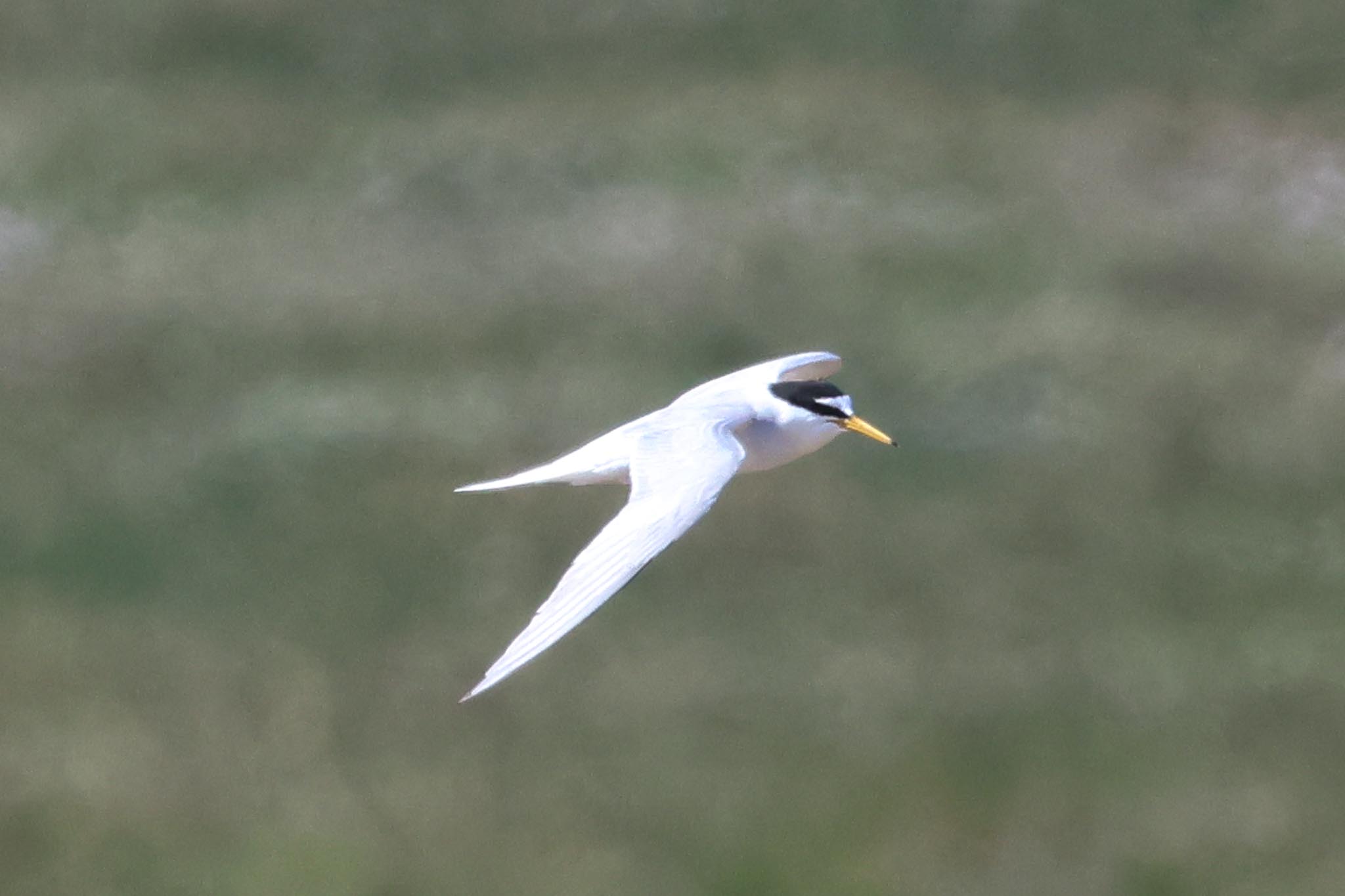
There were Sedge Warblers and Reed Warblers singing along the ditch below the bank and a couple of Common Pochard pulled out on the grass. A pair of Little Grebes swan past laughing. A Red Kite hung in the air above our heads.
Scanning up along the side of the channel, we found a distant Grey Plover in breeding plumage, a couple of Avocets and a Ringed Plover. There were not many waders on the mud out from the sluice now. A lone Brent Goose was in the channel in front of Gun Hill – the Brents have finally been leaving us in the last week, heading up to Siberia for the breeding season, and numbers have dropped sharply now. A Great White Egret flew past and dropped down into the reeds.
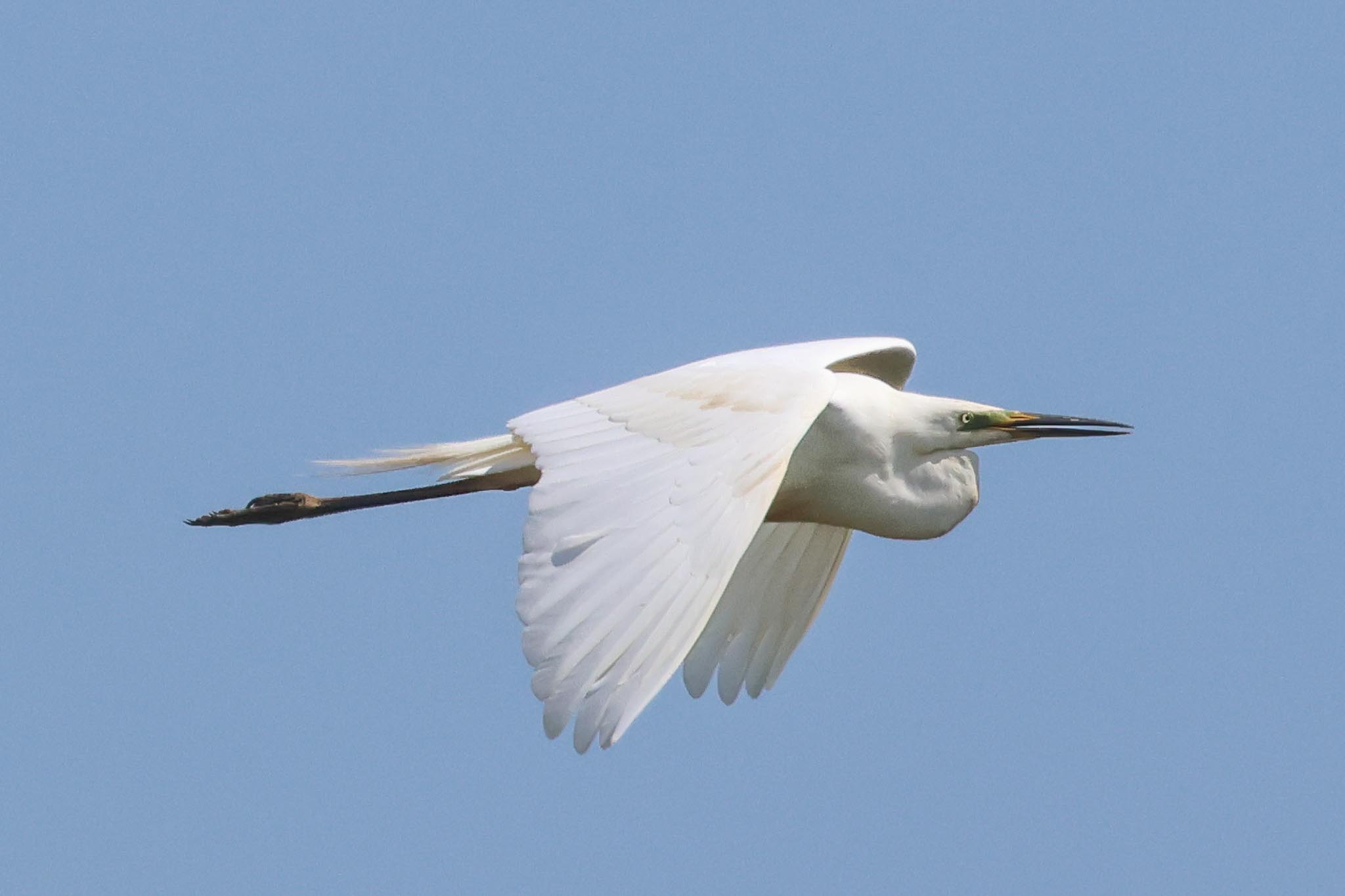
We could hear Bearded Tits calling in the reedbed but it was a bit too breezy and all we could manage today were several views of one zipping across over the top of the reeds. A Cetti’s Warbler shouted from the brambles. A couple of Marsh Harriers drifted back and forth. There was no sign of any Great Crested Grebes on the pool today.
We had seen several lone Spoonbills flying out over the bank already, presumably heading out to the harbour to feed, but now we picked up four Spoonbills flying towards us. They came past quite close, two adults and two immatures.
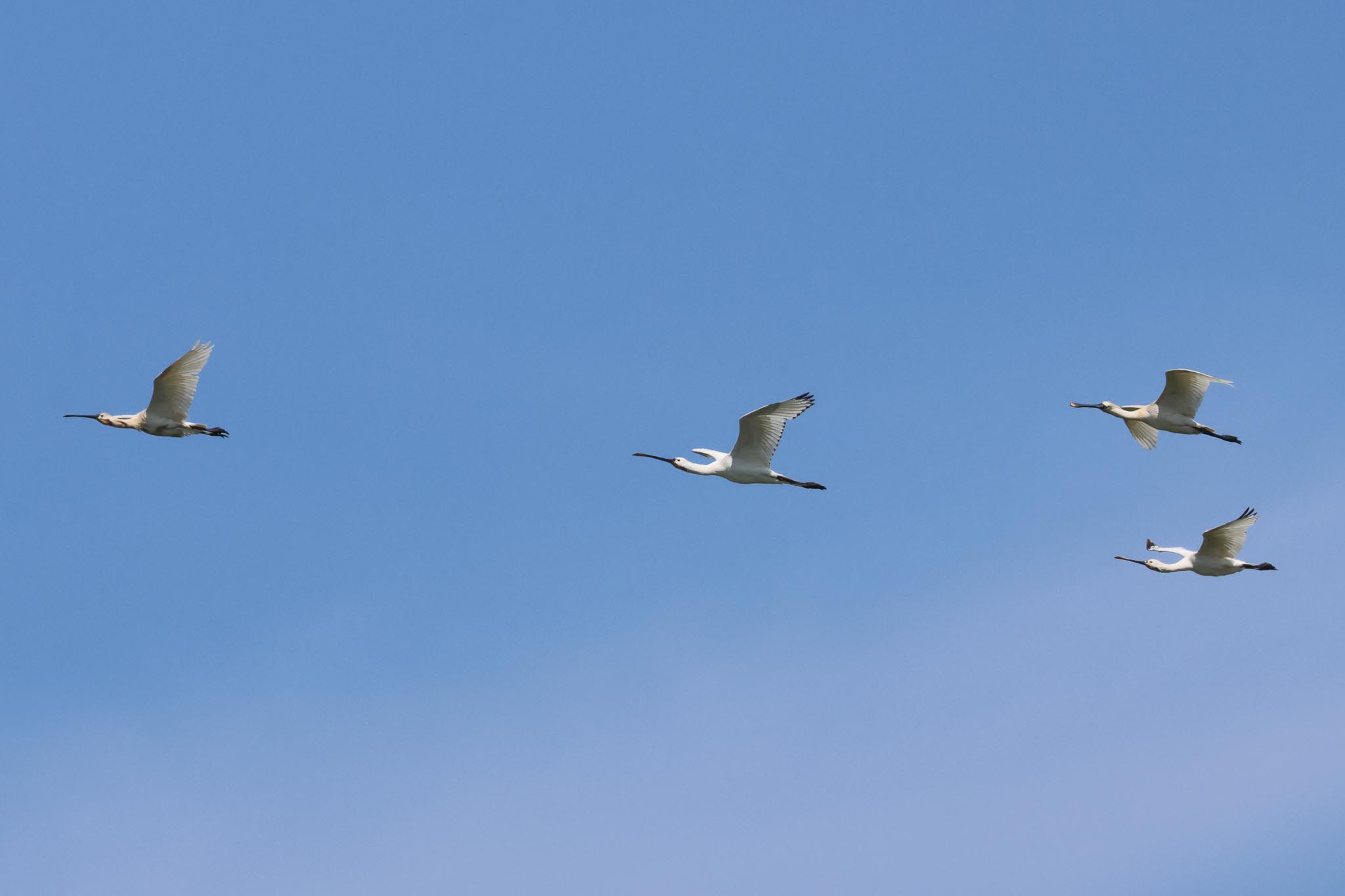
Scanning the pools beyond the reeds, we could see two Pink-footed Geese still with the Greylags and Canada Geese. Probably shot and injured by wildfowlers, a small number cannot make the journey back to Iceland to breed so stay here all year with the other geese. There were a five or six Black-tailed Godwits dozing here, along with the breeding Lapwings and Avocets. A pair of Redshanks were alarm calling from the edge of the saltmarsh below us.
Continuing on towards the dunes, we could see a small group of people watching the Red-backed Shrike. It was very mobile and most of the people left as we walked out – the bird was last seen heading east through the dunes so when we got to the boardwalk we were not sure whether we needed to go east or west. Thankfully we could see one person still who seemed to be looking intently through their scope towards Gun Hill and scanning the bushes we quickly located the Shrike distantly away to the west, a female. It dropped down onto the edge of the suaeda, then flew back up into the dunes, so we set off along the top path to see if we could get a better view.
Half way to Gun Hill, we stopped on the top of the dunes to scan and found the Red-backed Shrike back down on the edge of the saltmarsh, where we had a nice view of it hunting. It gradually worked its way further out, where it was mobbed by the local Reed Buntings and Meadow Pipits and became increasingly mobile again. A pair of Stonechats were feeding from the tops of the suaeda bushes too.
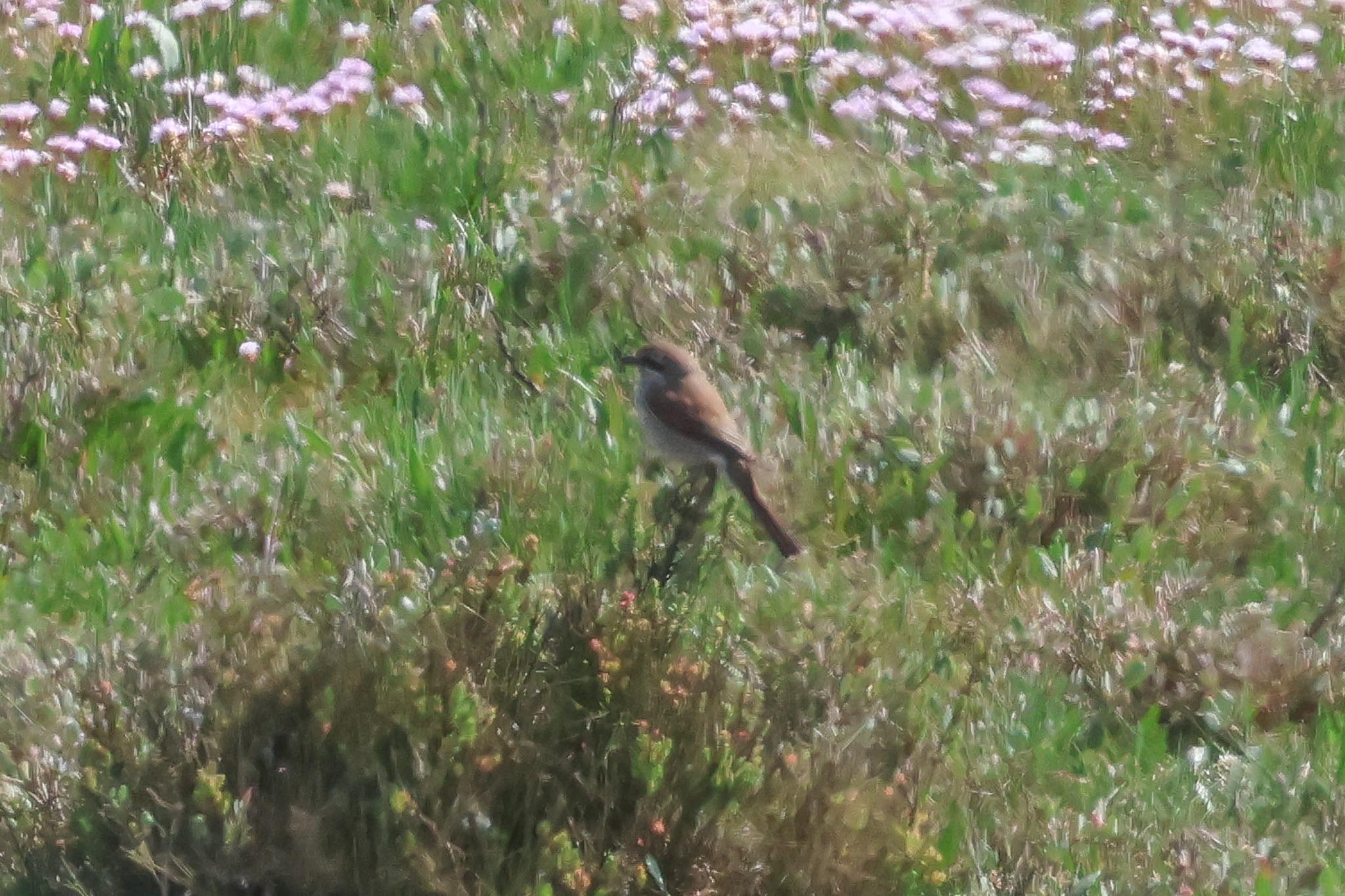
We had a quick look out to sea, where we picked up a couple of distant Sandwich Terns, then headed back through the dunes. There were lots of Linnets here and we eventually found a Wall Brown butterfly, which had been requested. The sun had just gone behind a cloud while we walked back, and needless to say when it came out again we saw lots more Wall Browns on the way back. We found a Small Copper too and we stopped to admire a Red-and-Black Froghopper in the alexanders on the bank too.
We could now see why the Redshanks had been alarm calling on the way out, as a small fluffy fresh juvenile appeared from the saltmarsh vegetation between them. A flock of Black-tailed Godwits came up from the mud by the sluice and there seemed to be something smaller and dumpier with them, so we walked back to have a closer look. The Black-tailed Godwits flew up again when we got there, but there was nothing with them as they settled back down on the mud. There were a couple of smart summer plumaged Turnstones here now and two Ringed Plovers.
Back to the minibus, and we drove back to Hunstanton. It had been a productive first afternoon, and we had more to look forward to tomorrow.
Thursday 25th May
We headed east along the coast this morning, to Cley. We had a quick stop to use the facilities and admire some moths at the moth morning which was underway, until the Visitor Centre opened. Then we headed out to the central hides.
There had been some stints on Simmond’s Scrape earlier, so we made straight for Dauke’s Hide. We quickly got the scope on a smart rusty breeding plumage Little Stint on one of the islands and the next thing we knew it was joined by a second stint, this time a Temminck’s Stint. It is unusual to see the two species together here so this was a good opportunty to compare them side by side.
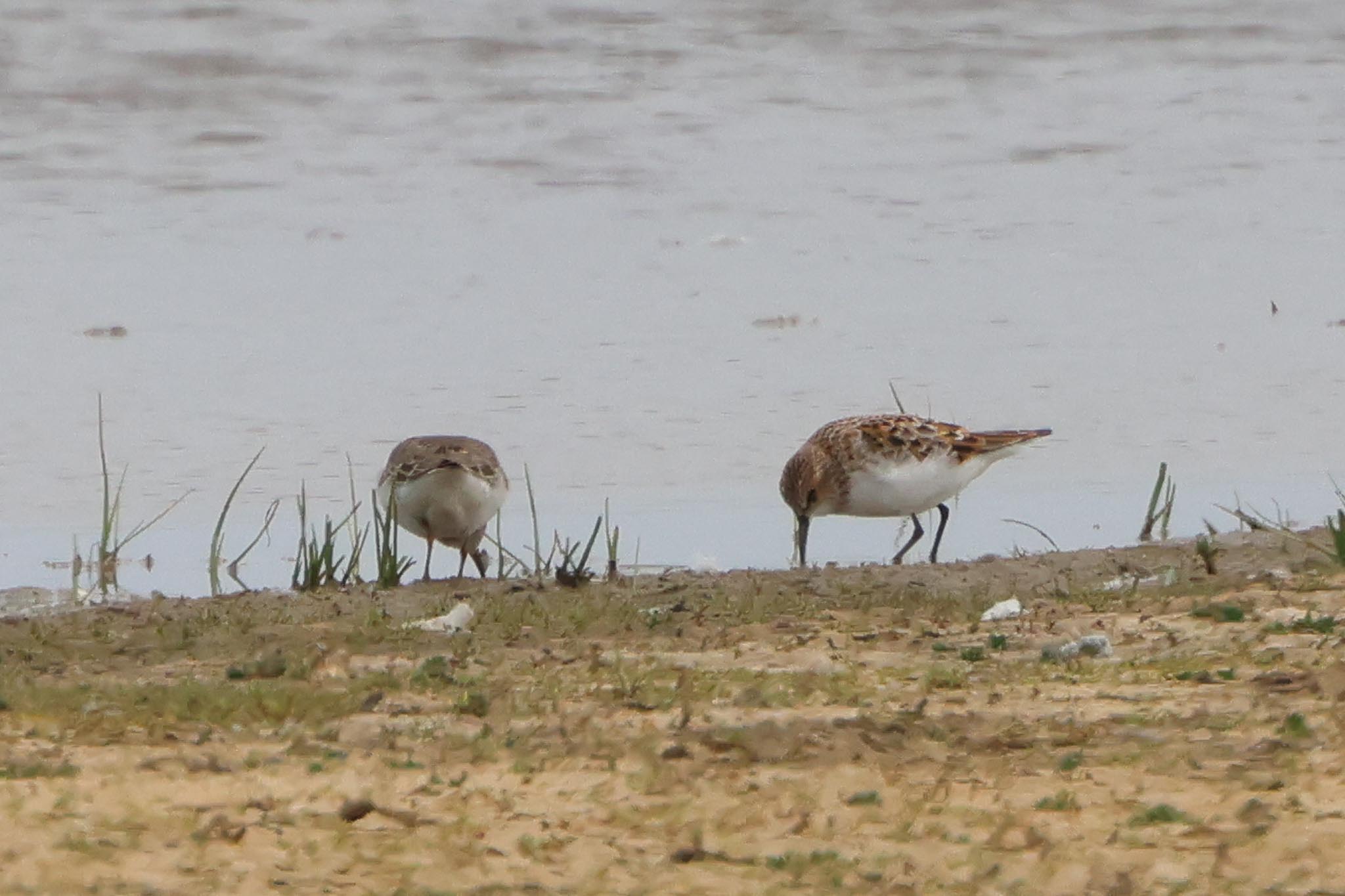
There were four Common Sandpipers and a couple of Little Ringed Plovers on here too, but everything kept getting chased round by the Avocets. They have small juveniles now, and the adults are in the habit of chasing absolutely everything else off. Not very helpful! Two Little Terns landed on one of the islands.
Two Spoonbills appeared on Pat’s Pool, adults in breeding plumage. We got the scopes on them so we could admire their bushy nuchal crests. Then a shout from one of the locals alerted us to a Bittern which was flying across over the reedbed beyond. We watched it as it looped round over Bishop Hide and then dropped into the reeds beyond. A nice bonus!
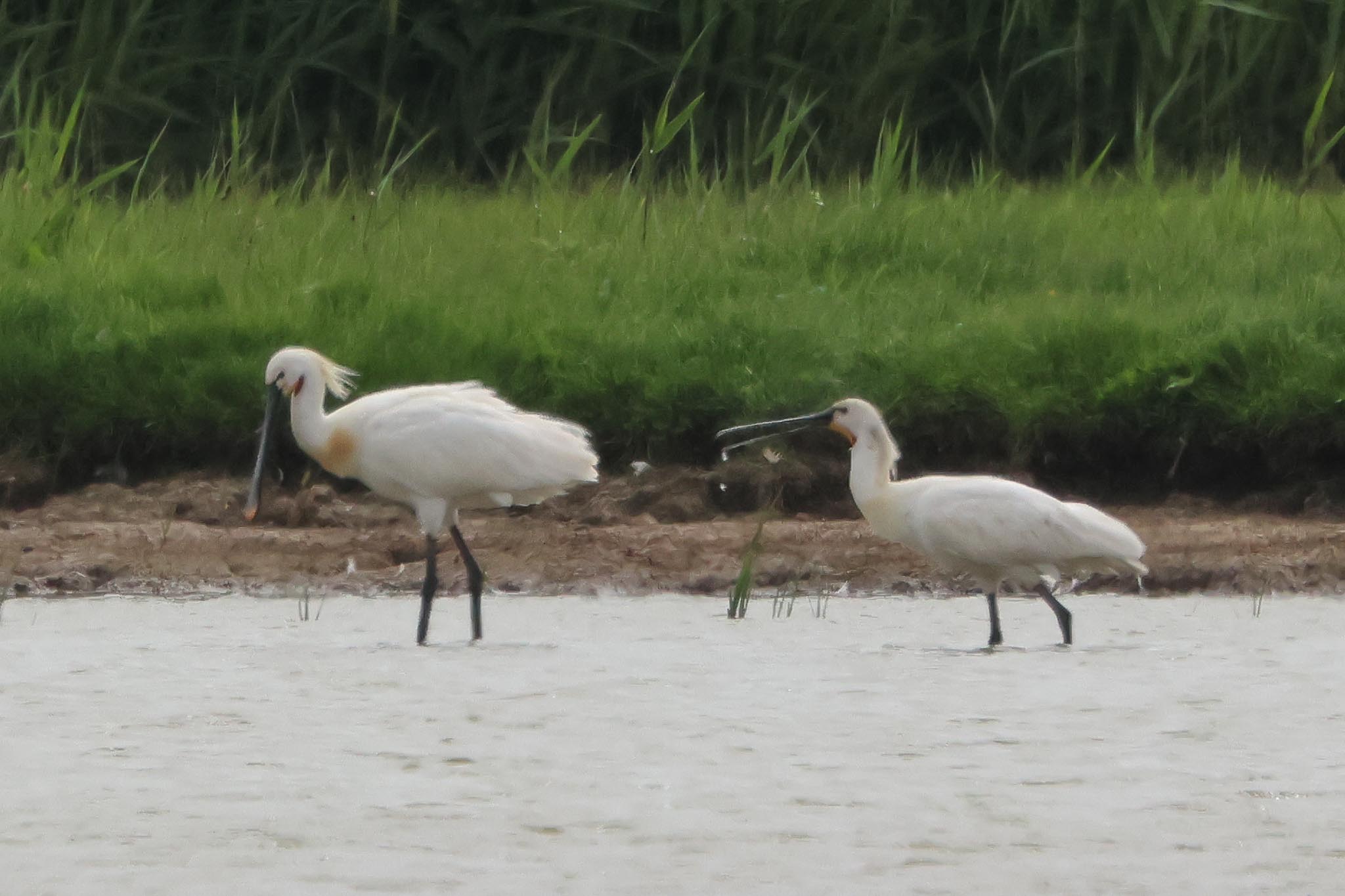
Mission accomplished here with the stints, we headed back to the Visitor Centre. After a short break to admire a moth which someone had brought in – Norfolk’s first Banded Pine Carpet, a rare migrant here in the UK – we then headed out onto the reserve again.
We headed down along the Skirts path to the East Bank. A female Common Pochard was down on Don’s Pool and a Little Grebe showed itself briefly between the reeds further back. We could hear Bearded Tits calling, but it was quiet breezy up here and they were keeping well down out of sight. A male Marsh Harrier flew towards us across the reeds and over the bank ahead of us. Several Sand Martins were hawking low over the reedbed looking for insects.

The smaller pools on the grazing marsh are drying out quickly now, so we pressed on towards the Serpentine. There was more water here but not much in the way of birds today – Lapwing and Avocet, and a few ducks. There were a couple of young Great Black-backed Gulls with the Cormorants on Pope’s Pool beyond.
We found some shelter from the breeze on the back of the shelter overlooking Arnold’s Marsh. There were a couple more Little Terns on the brackish pools but it looks like the last of the Pintail has finally moved on. Out on Arnold’s Marsh, there were also fewer birds today, though we did find two Grey Plover towards the back, including one in smart black-faced breeding plumage.
On to the beach, and a Whimbrel flew over the shingle and disappeared off west as we arrived. We had a glimpse of a Gannet which appeared briefly above the shingle earlier, but there was not much moving offshore now, so we turned to walk back. It was lunchtime, so the pace picked up and we headed back to the picnic area at the Visitor Centre for a late lunch.
Afterwards, we drove east to Kelling. It was a bit more sheltered in the lane as we walked down towards the Water Meadow. We stopped to watch a couple of Brown Hares in the field next to the lane and two Red-legged Partridges walked past. A Chiffchaff was singing from a dead tree above the path and a Blackcap was singing from the copse. Scanning from the gate, we could see several more Brown Hares on the slope beyond.

There were a few ducks on the Water Meadow Pool, but no sign of anything else. The resident pair of Egyptian Geese were hiding in the beck on the Quags and a Grey Heron appeared from the bank in front of them. There were several Linnets in the brambles on the far side of the Water Meadow.
Continuing on down towards the Hard, we turned up along the permissive path towards the gun emplacements. A Common Blue butterfly was fluttering around the short grass. There were more Linnets and Meadow Pipits here and a male Stonechat appeared on the bushes before flying up to perch on the concrete by the guns. There didn’t appear to be much out to the sea off here either, but one of the group spotted a single female Common Scoter asleep on the water off to our left.
We had been intending to call in at Stiffkey Fen on our way back, but we were short of time now and everyone had probably done enough walking for the day. Instead, we popped in briefly at North Point instead. There were lots of gulls on the east pool, including a good number of Lesser Black-backed Gulls. There were lots of Redshanks on the pool west of the track and one of the group had a glimpse of something which looked smaller, so we set off down the track to see if we could find it again. We couldn’t, but we did have nice close views of a Little Ringed Plover and a Common Sandpiper both on the near edge of the pool to the east now.
We had quite a long drive back to Hunstanton (and a malfunctioning camera to deal with), so it was time to call it a day and head for home.
26th May 2023
Today we headed in the other direction, and drove over towards the Wash at Snettisham. As we got out of the minibus, we could hear a Cuckoo calling from somewhere away over the marshes, but we couldn’t see it from here. As we walked up towards the Coastal Park, a couple of Bullfinches flew over the road but disappeared behind the bushes ahead of us.
A pair of Turtle Doves flew out of the bushes and dropped down through the trees the other side of the inner seawall as we passed, so we turned and walked up a short way to see if we could find them. We couldn’t, but we did have nice views of a Common Whitethroat singing in the bushes nearby. As we got back to the road, another Turtle Dove did the same thing, flew across the inner seawall and dropped down through the trees.
We decided to try our luck in the Coastal Park and we hadn’t gone far when we found another Turtle Dove on the wires. We got it in the scope, and even though we were looking into the sun we had a nice view of it now. A Turtle Dove started purring now from the bushes a bit further up, so we walked on to see if we could see that one, as the light would be much better. When we got there, we realised there were now three Turtle Doves purring. We eventually got one perched in the top of one of the hawthorns and had great views of it through the scopes.
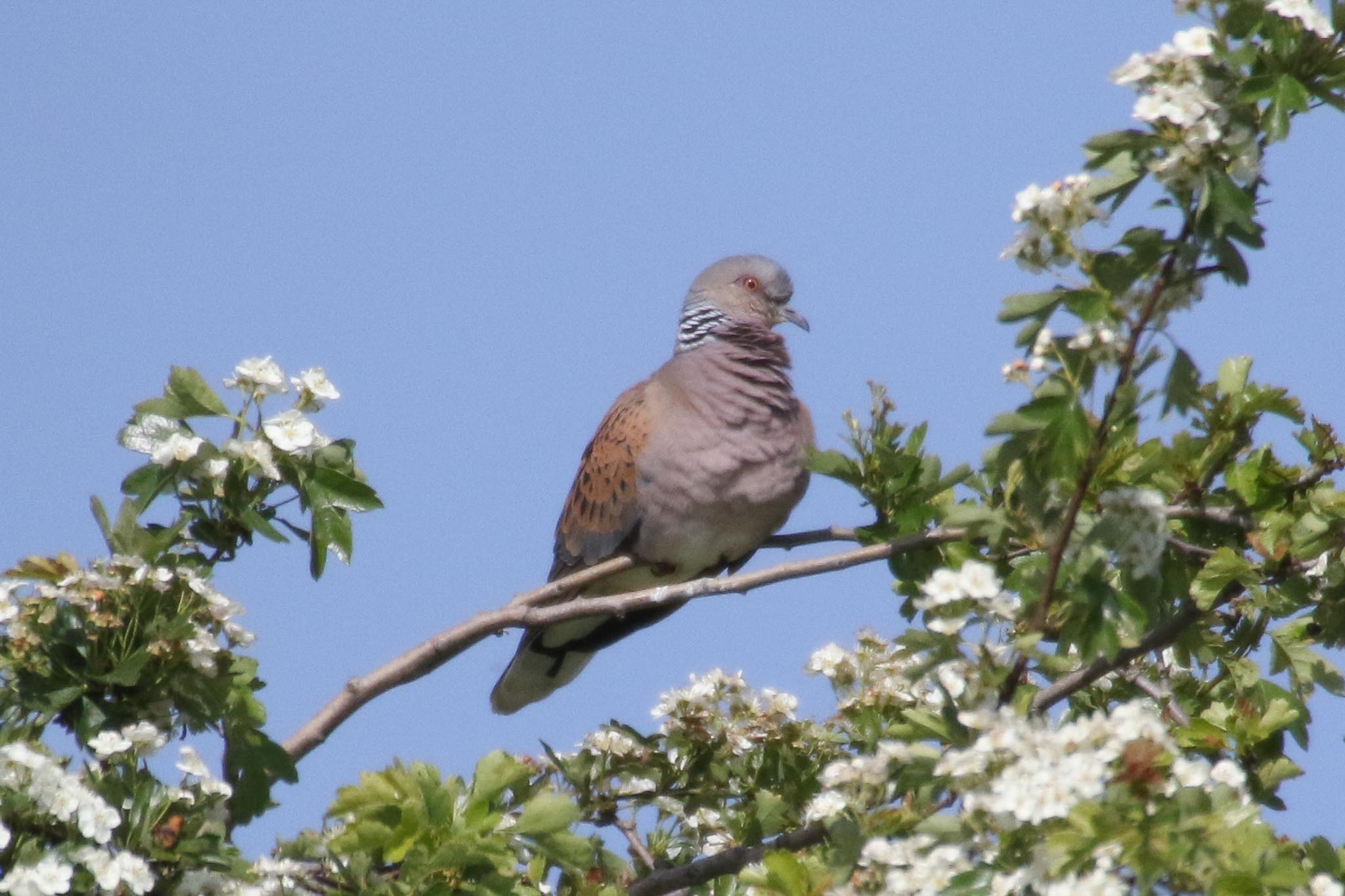
The Turtle Doves were displaying too, periodically flapping up into the sky, before gliding round with tail spread and dropping slowly back down into the trees. One circled right above our heads at one point. A magnificent sight and sound and so sad it has become so rare now.
There were still a few warblers singing – a Lesser Whitethroat rattled from deep in the bushes, we saw a couple of Common Whitethroat, one or two Blackcap were singing and lots of Chiffchaffs were chiffing and chaffing. A Reed Warbler obviously hadn’t read the field guide because it was singing from the bushes out towards the beach.
As we got to the open area, we heard a Cuckoo calling from towards the seawall, so we walked up to the concrete path and looked out at the burnt bushes the other side. The Cuckoo was there, but in the one bush with leaves which was just over the bank. We could see it perched in the top and got it in the scope, but it flew off before everyone could get a good look at it.
Cutting back across to the seawall, we climbed up and looked out across the Wash. The Ringed Plover was still on its nest in the cage on the beach and a couple of Oystercatchers were sleeping on the sand beyond. A little group of Sanderling were feeding along the shore, but kept getting pushed up and down by several dogwalkers – at least the dogs were put on leads today to walk past the cordons. The Sanderling look very different in breeding plumage, much darker than how we normally see them in winter, and they are very variable too, a pitfall for the unwary.
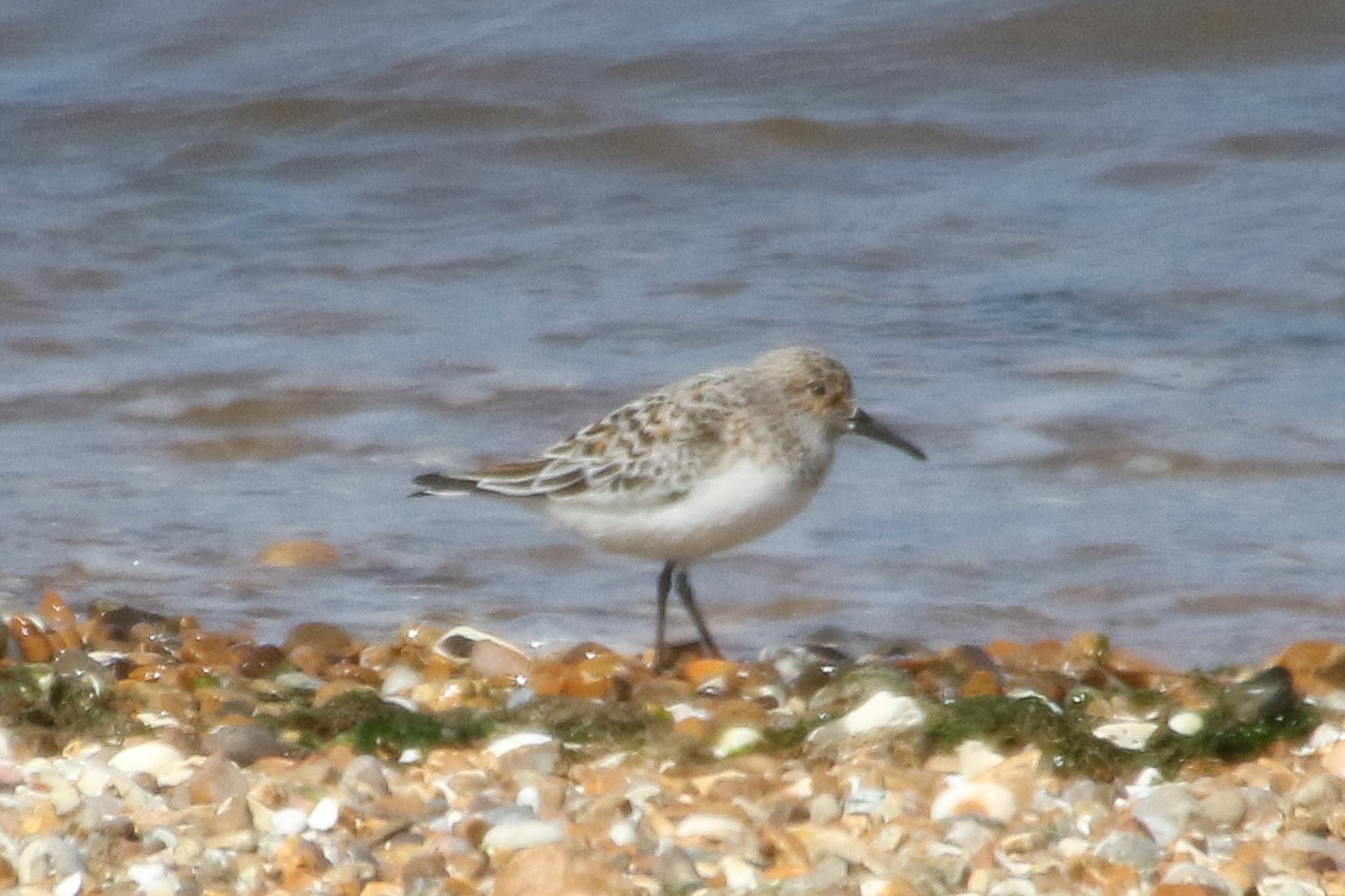
We walked on along the top of the seawall, surveying the destruction wrought by last summer’s fire. There were more Linnets and Meadow Pipits here and several more butterflies. We stopped when we got to the concrete bank and a Cuckoo flew in and landed in the top of a burnt bush close to us. Another Cuckoo flew in behind and the first flew after, presumably a male chasing after a female, we could hear the former calling as they wove in and out of the charred trees. A Turtle Dove flew in and dropped down nearby into the weedy vegetation which is growing up on the bank.
We cut across to the inner seawall and climbed up to scan Ken Hill Marshes the other side. One of the group spotted a Kingfisher on the fence further up, which we got in the scopes. It kept dropping down, presumably to fish in the ditch below, then landed back on another post a bit further along.
We walked on up along the bank until we could see the northernmost pools on Ken Hill Marshes. They are drying out quickly and getting very overgrown now, but we could see several hundred Oystercatchers roosting on there over high tide. A single grey Knot was in with them. The number of Black-tailed Godwits here has dropped, just two asleep today, and we couldn’t see any other waders beyond the resident Avocets, Lapwings and Redshank. One of the group glimpsed a Snipe on the pool in front of us, but it put its head down and we couldn’t find it in all the vegetation.
A smart male Marsh Harrier had been working up and down the inner seawall as we walked up and drifted past us a couple of times now as we started to walk back. A Turtle Dove was purring from the pine tree in the middle of the burnt area of the park. The southern part of Ken Hill Marshes is very overgrown this year and the only thing of note we saw on their was a pair of Little Grebes on the biggest pool.
We had to stop at the hotel to drop off one of the group, who had to get back, and after a break to use the facilities too it was time for a late lunch by the time we got round to Titchwell. Afterwards, we set off out to explore the reserve. There had been a Red-backed Shrike on the hedge along the side of the Thornham grazing meadow this morning, but checking in at the Visitor Centre, we heard that it hadn’t been seen for at least a couple of hours and had possibly moved off west.
It was warm in the shelter of the trees, but cool in the wind once we got out. There were several Swifts hawking low over the reedbed and Marsh Harriers hanging in the breeze further back. There were Reed Warblers and Sedge Warblers singing and we had the typical glimpse of a Cetti’s Warbler as it darted across a gap in the vegetation, but the Bearded Tits were very quiet today, perhaps not a surprise given the wind. A Grey Heron was hunting in one of the smaller pools and another was standing statuesque, like a pond ornament, in one of the pools by the main path.
We had a glimpse of a Little Gull which dropped down towards the freshmarsh over the far side of the reeds, so we continued on to the bank by Island Hide. We could see two Little Gulls hawking back and forth low over the water now, both 1st summers with black ‘w’ patterns on their wings. Several Common Terns were on the nearest island among the breeding Black-headed Gulls, several of which have fluffy young hatching now.
Someone came out of the hide to tell us that the Garganey, which had been feeding along the edge of the reeds, had flown off. We were just about to move on when it reappeared, swimming out from behind a line of reeds. It came much closer, down into the near corner, chased at one point by an aggressive Mallard. A male moulting into eclipse already, the Garganey is not at its smartest but still nice to see, possibly the same bird which has been at Thornham regularly recently. A female Common Pochard with seven tiny ducklings swam into the near corner too.
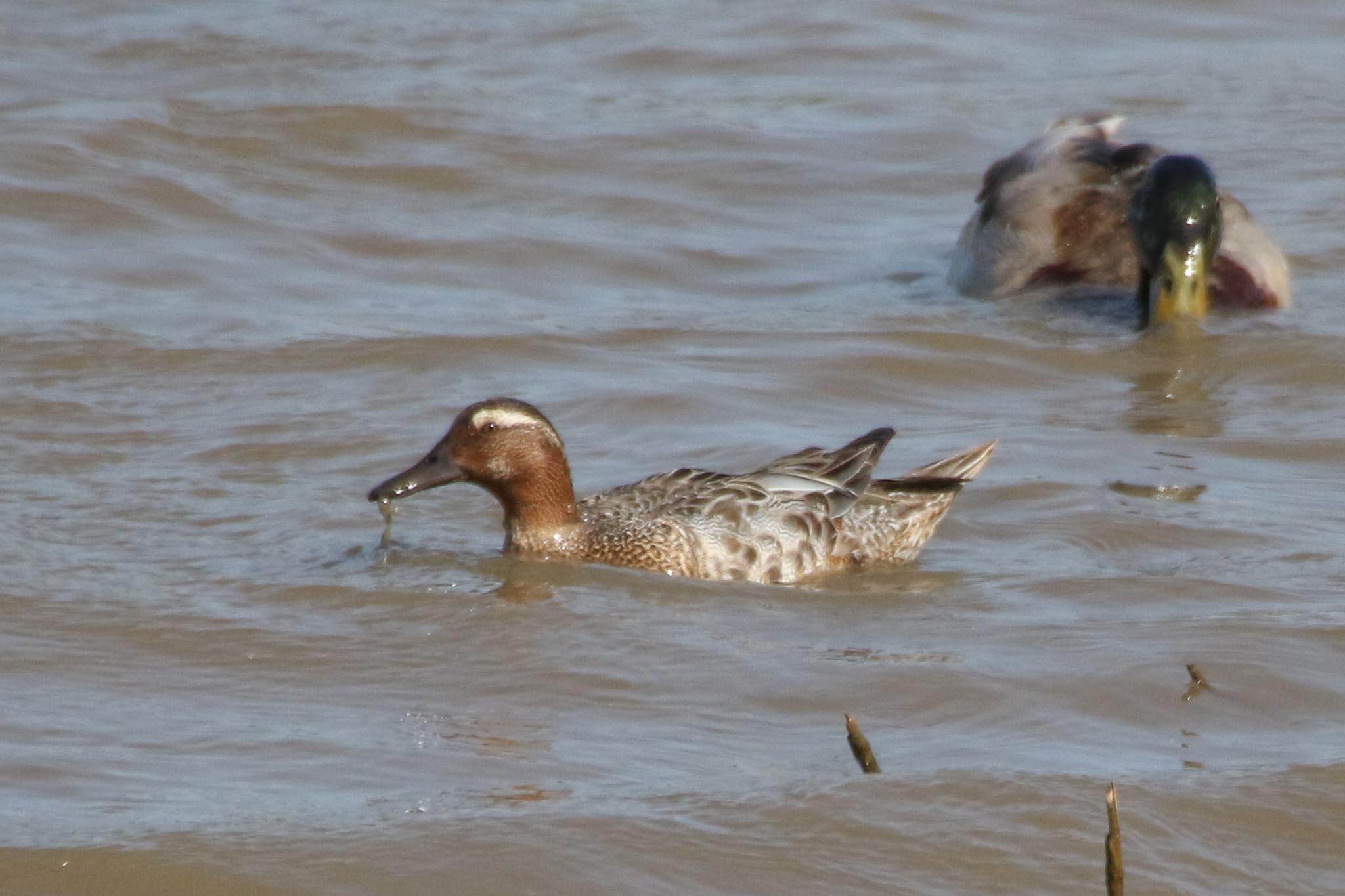
Continuing past Island Hide, we stopped again to scan. We turned the scope on a pair of Mediterranean Gulls on one of the islands right at the back, still standing out with their jet black hoods, excessive white eye-liner, and brighter red bills. A couple of Little Terns were just visible on one of the other islands. There were some drake Common Pochard dozing on the new bund and one or two Tufted Ducks too.
We pressed on round to Parrinder Hide, where we would be out of the wind and in the sun. We went into the further section to scan the far compartment of the Freshmarsh first, getting a slightly better view of the Mediterranean Gulls from here. Then we noticed the Little Stint on the mud in from of the other part of the hide. We had a look at it in the scopes from here, then crossed over for a closer look. It was getting absolutely no peace from the Avocets, which were chasing it round relentlessly whenever it landed. There was only one part of the far shore where it seemed to escape their attention – not a nice welcome for such a long-travelled visitor!
We decided to brace the breeze and make a bid for the beach. There was not much on Volunteer Marsh as we passed, but we did find a smart breeding plumage Turnstone on the back of the Tidal Pools. There were more waders out on the mussel beds – lots of Sanderling, six northbound Tundra Ringed Plovers (the northern subspecies tundrae of Common Ringed Plover), a couple of Curlew and several Bar-tailed Godwits including one male in rusty breeding plumage. Some distant Sandwich Terns flew past over the sea.
It was time to head back – and get out of the wind. As we passed the Tidal Pools, a Spoonbill flew over and disappeared off east. A Cuckoo was calling from the back of the reedbed now. We had a quick look to see if the Red-backed Shrike might have reappeared, but still no sign, so it was time to call it a day.
Saturday 27th May
A half day again today, and we planned to use the morning to try to catch up with a couple of things we had missed. First we had a quick look at Holkham to see if we could find any Grey Partridge. They are breeding at the moment, and with the vegetation in the fields high now too, they are not as easy to find as they are in the winter. Unfortunately there was no sign of either of the pairs along Lady Anne’s Drive, where the vegetation is still relatively short, although we did hear a Willow Warbler singing in the trees.
The Long-billed Dowitcher had been seen on each of the previous two mornings from the seawall at Burnham Overy with the Black-tailed Godwits (presumably the same bird we had glimpsed there on Wednesday), so we walked out next to see if we could catch up with it on the rising tide. We walked down Whincover this time, across the grazing marshes. A Common Whitethroat was singing from the parking area as we got out and a Yellowhammer flew over the track as we started down.
A Chiffchaff was singing above us from the hedge and down at the gate, the same or another male Yellowhammer perched nicely for us in the top of a tree. There were a couple of Sedge Warblers and Reed Warblers singing from the ditches by the track and a Cetti’s Warbler flew across. We saw several more Wall Brown butterflies along the track too.
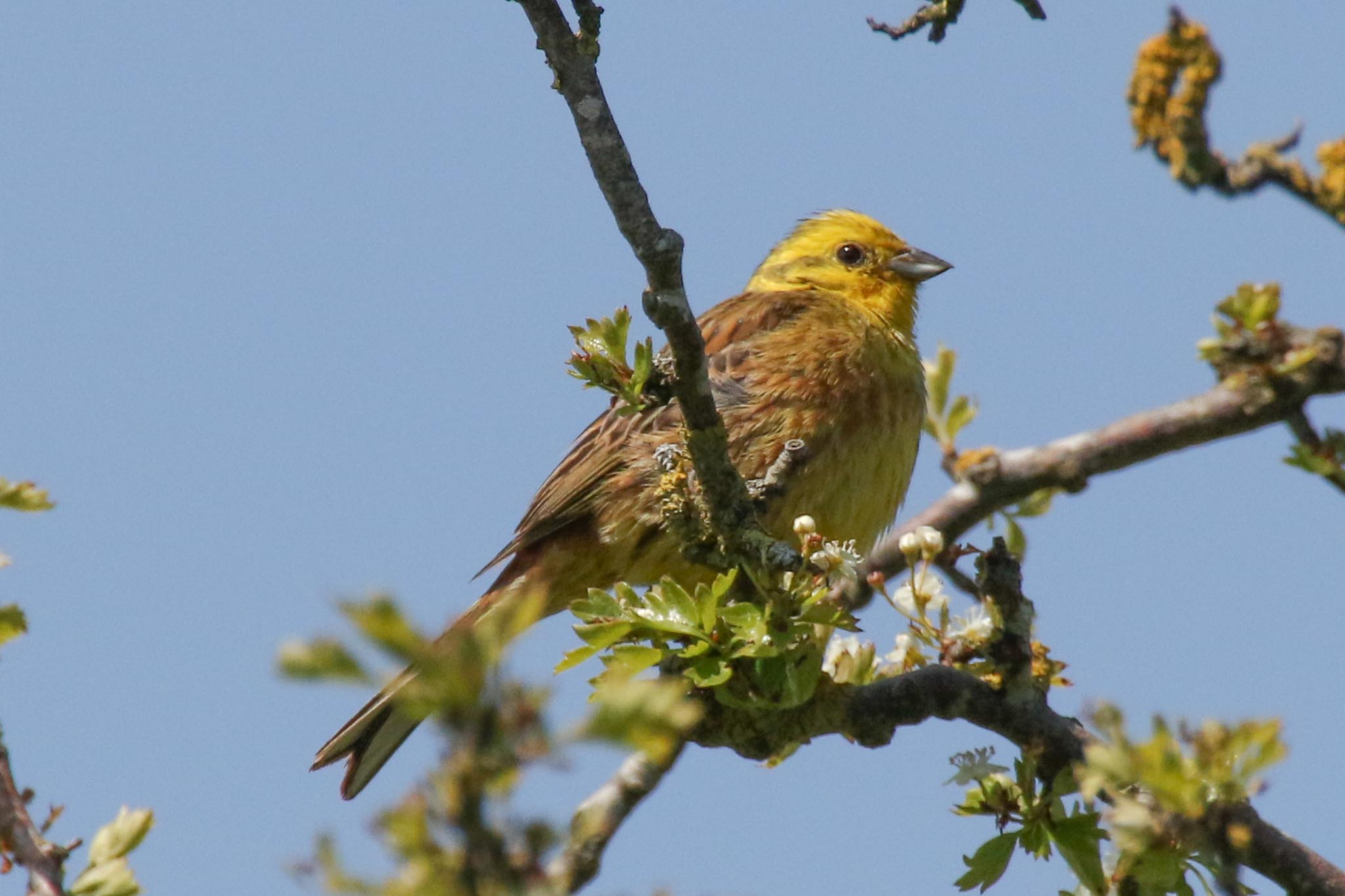
When we got up onto the seawall, there was no sign of any Black-tailed Godwits on the mud. Another group was just leaving so we asked them what they had seen. The godwits had apparently been spooked by some swimmers and flown off towards Holkham. Someone earlier had claimed to have seen something smaller with them, but apparently when they flew off they were on their own.
There was a nice Great White Egret perched up in the reeds and a Marsh Harrier. The pair of Great Crested Grebes had reappeared today on the pool. We walked a little further up, to look at the muddy scrapes just beyond the reedbed, but there were only two Black-tailed Godwits on there today and nothing with them either. We decided to head back.
We had a quick look in at Stiffkey Fen to finish. An Oystercatcher was tucked down in the flowers opposite the layby when we pulled up and a Lesser Whitethroat was singing in the hedge along the permissive footpath beyond. A family of Long-tailed Tits were in the trees by the river as we set off along the footpath down towards the seawall. Looking over the brambles towards the Fen, we could see a Little Ringed Plover displaying and a Marsh Harrier appeared above the reeds.
From up on the seawall, we could see a single Spoonbill over in the far corner which we got in the scopes before it flew off back out over the harbour. There were at least five Little Ringed Plovers now, but no sign of any other unusual waders. With the bright sunny weather over the last couple of days, there appeared to have been a bit of a clear out.
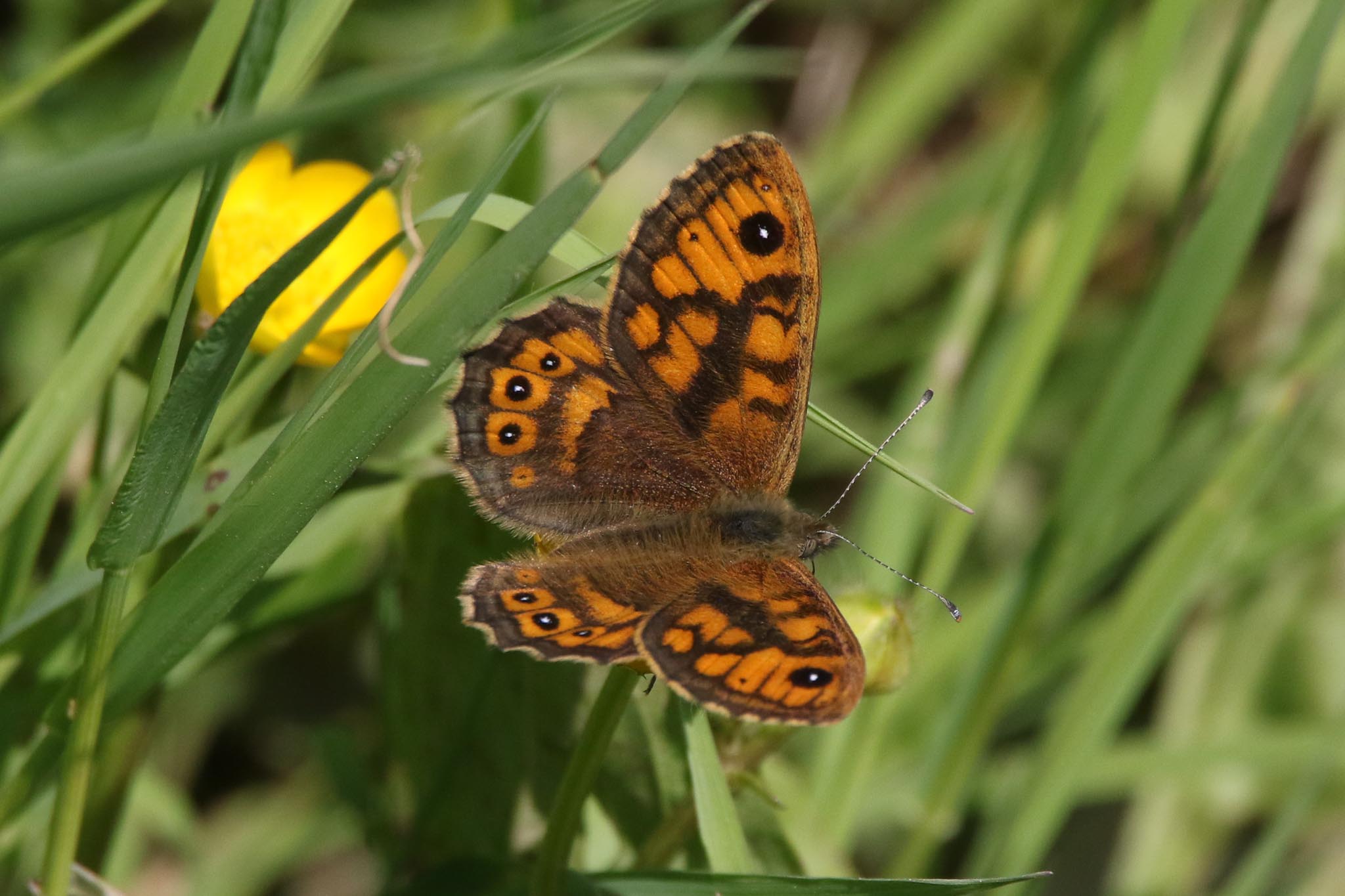
There had been an Osprey reported over Blakeney Harbour this morning, but despite scanning we could find no sign of it now. It is a beautiful view from here though, looking out over towards Blakeney Point, so we spent the last minutes of the morning in the sunshine enjoying the vista, before it was time to head back to Hunstanton and wrap up the tour.
















